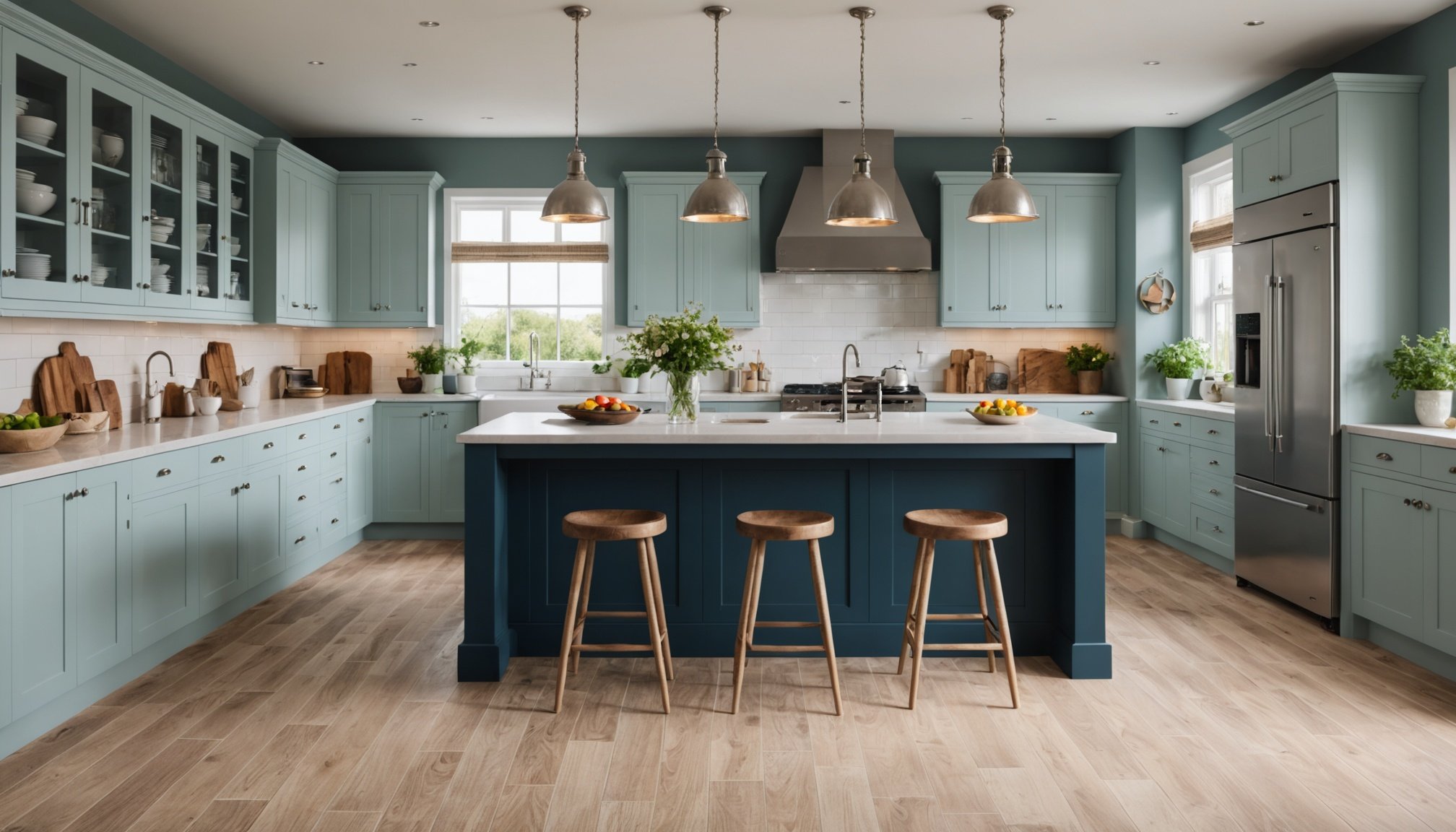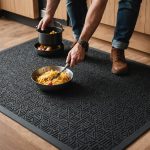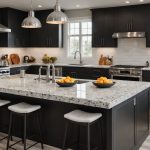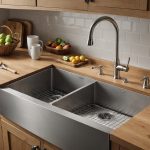Choosing the right kitchen flooring for your coastal home in the UK involves more than aesthetics; it’s about functionality and resilience. Coastal environments pose unique challenges, from humidity to sand. This guide explores durable options that complement seaside decor while standing up to the elements. With various materials available, you can create a beautiful, practical space that reflects your coastal lifestyle. Let's delve into the best flooring choices tailored for your coastal kitchen.
Understanding Coastal Home Requirements
When selecting flooring for coastal homes, it's crucial to consider specific environmental factors. Coastal regions often experience high levels of moisture, which can be detrimental to traditional flooring materials. Therefore, choosing flooring with excellent moisture resistance is essential to prevent warping and damage.
Additional reading : Discover the Most Innovative Eco-Friendly Dishwashing Solutions for UK Households in 2023
Moisture Resistance
Coastal areas are characterized by constant humidity and occasional flooding. Flooring materials like ceramic tiles or vinyl are highly recommended due to their natural resistance to water. This ensures longevity and reduces maintenance costs.
Temperature and Humidity Fluctuations
The temperature fluctuations in coastal regions can cause expansion and contraction in flooring materials. Engineered wood is a viable option here, as it can withstand these changes better than solid wood. It maintains its structure and appearance, ensuring durability.
Topic to read : Discover the Most Innovative Eco-Friendly Dishwashing Solutions for UK Households in 2023
Aesthetic Alignment
Aligning with coastal design themes enhances the ambiance of a coastal home. Light-colored flooring options, such as bleached wood or pale stone tiles, complement the airy and relaxed aesthetic typical of coastal interiors. They not only add to the visual appeal but also reflect the natural beauty of the surroundings.
- Moisture Resistance: Prevents damage
- Temperature Fluctuations: Requires flexible materials
- Aesthetic Alignment: Enhances coastal themes
Choosing the right flooring can significantly impact the functionality and beauty of a coastal home, ensuring it withstands environmental challenges while maintaining its charm.
Popular Kitchen Flooring Options
Exploring the best kitchen flooring materials is essential for creating a durable and appealing coastal kitchen.
Tiles
Tile flooring is a popular choice for coastal kitchens due to its durability and resistance to moisture. Ceramic and porcelain tiles are particularly suitable, as they withstand humidity and spills effectively. They offer a wide range of design options, from classic to contemporary styles, allowing homeowners to customize their space.
Pros of tile flooring include its long lifespan and ease of cleaning. However, it can feel cold underfoot and may require additional heating solutions. Regular maintenance involves sealing grout lines to prevent stains and mold growth.
Maintenance tips for tile flooring include using a mild detergent for cleaning and avoiding abrasive cleaners that can damage the surface. It's advisable to check for any cracks or chips regularly and address them promptly to maintain the integrity of the flooring.
- Types of tiles: Ceramic, Porcelain
- Pros: Durable, Moisture-resistant
- Cons: Cold, Requires grout maintenance
Choosing the right tile for a coastal kitchen ensures a balance between functionality and aesthetics, making it a smart investment for long-term satisfaction.
Style and Aesthetic Considerations
Exploring the visual elements of coastal kitchen design can enhance the charm and functionality of your space.
Color Palettes
Incorporating color palettes that reflect the serene beauty of the coast is essential. Soft blues, sandy beiges, and crisp whites create a calming atmosphere reminiscent of the ocean. These hues can be complemented by pops of coral or seafoam green for a refreshing touch.
Natural Textures and Materials
Natural textures play a significant role in coastal kitchen design. Consider using materials like rattan, driftwood, or jute to add depth and interest. These elements can be seamlessly integrated into cabinetry, furniture, or accessories, enhancing the overall aesthetic.
Complementing Kitchen Elements
Choosing flooring that complements other kitchen elements is crucial for a cohesive look. Light-colored wood or stone tiles can harmonize with coastal design features such as open shelving, glass-front cabinets, or nautical-inspired decor. This integration ensures that each component of the kitchen contributes to a unified and inviting environment.
- Color Palettes: Soft blues, sandy beiges
- Natural Textures: Rattan, driftwood
- Kitchen Elements: Open shelving, glass cabinets
The strategic use of color and texture in coastal kitchen design not only elevates style but also enhances the overall ambiance.
Durability and Longevity Factors
Exploring flooring options for coastal kitchens requires a focus on durability and longevity.
Evaluating Wear and Tear
Durable kitchen flooring is essential in high-traffic areas, where wear and tear are inevitable. Materials like ceramic tiles and engineered wood offer superior resistance to daily use, making them ideal choices for busy kitchens. Their robust nature ensures that they maintain their appearance and function over time.
Resistance to Moisture and Corrosion
In coastal environments, resistance to moisture and corrosion is crucial. Flooring options such as vinyl or porcelain tiles are designed to withstand moisture, preventing corrosion and damage. This resistance is vital for maintaining the integrity of the flooring, especially in areas prone to spills and humidity.
Lifespan Comparison
When comparing the lifespan of different flooring materials, it's important to consider both initial costs and long-term benefits. Here's a quick comparison:
| Material | Lifespan (Years) | Maintenance Level |
|---|---|---|
| Ceramic Tiles | 20-30 | Low |
| Engineered Wood | 15-25 | Moderate |
| Vinyl | 10-20 | Low |
Choosing the right durable kitchen flooring ensures that it withstands the unique challenges of a coastal environment, providing a lasting and practical solution.
Maintenance and Care Tips
Ensuring your kitchen flooring remains in top condition requires understanding the unique demands of coastal environments.
Regular Cleaning Routines
In coastal areas, regular cleaning routines are essential due to the high humidity and potential for sand and salt accumulation. For ceramic tiles, use a damp mop with a mild detergent to prevent grime buildup. Vinyl flooring benefits from weekly vacuuming and occasional mopping with a non-abrasive cleaner to maintain its shine.
Specific Care for Different Flooring Types
Each flooring type demands specific care techniques. Engineered wood requires a soft-bristle broom or vacuum with a hardwood setting to avoid scratches. Periodically, use a wood cleaner to maintain its luster. Porcelain tiles, known for their durability, should be cleaned with a vinegar-water solution to tackle any stubborn stains without damaging the surface.
Seasonal Maintenance Considerations
Seasonal changes in coastal regions necessitate additional care. During humid months, ensure proper ventilation to reduce moisture levels, which can affect flooring integrity. In drier seasons, consider using a humidifier to prevent engineered wood from drying out and cracking.
- Regular Cleaning: Essential for longevity
- Specific Care: Tailored to material type
- Seasonal Maintenance: Adapts to climate changes
By following these maintenance tips, you can ensure your kitchen flooring remains durable and visually appealing.
Case Studies of Coastal Kitchens
Exploring real-life examples for inspiration and guidance.
Successful Flooring Choices
In coastal kitchens, selecting the right flooring is pivotal. One remarkable example is a beach house in Malibu, where homeowners opted for porcelain tiles. This choice provided exceptional moisture resistance, crucial for the humid climate. The tiles' durability ensured minimal wear and tear, even in high-traffic areas.
Design Decisions and Impacts
A coastal kitchen in the Hamptons showcases the impact of color palettes and natural textures. By integrating soft blues and sandy beiges with rattan accents, the design achieved a serene, cohesive atmosphere. The use of engineered wood flooring complemented these elements, offering both aesthetic appeal and resistance to temperature fluctuations.
Lessons Learned
These case studies highlight valuable lessons for coastal kitchen renovations. Prioritizing moisture-resistant materials like ceramic tiles or vinyl ensures longevity. Emphasizing aesthetic alignment with coastal themes enhances the overall ambiance.
- Key Takeaways:
- Material Selection: Crucial for durability
- Design Cohesion: Enhances visual appeal
- Practicality: Balances beauty and function
These insights guide homeowners in making informed decisions, ensuring their coastal kitchens are both beautiful and resilient.
Budgeting for Kitchen Flooring
Exploring cost-effective strategies for your coastal kitchen flooring.
Cost Comparisons
When considering kitchen flooring costs, it's essential to compare different options. Ceramic tiles are generally affordable, ranging from $3 to $7 per square foot. Engineered wood is pricier, typically costing between $6 and $12 per square foot. Vinyl flooring offers a budget-friendly alternative, with prices from $2 to $5 per square foot.
Long-term Value
While initial costs are important, consider the long-term value. Ceramic tiles may have a higher upfront cost, but their durability and low maintenance make them a wise investment. In contrast, vinyl flooring might require more frequent replacement, impacting its long-term cost-effectiveness. Engineered wood offers a balance, providing aesthetic appeal and moderate longevity.
Budgeting Tips
To effectively manage kitchen flooring costs, create a detailed budget. Research local suppliers to find competitive prices and consider purchasing during sales. Prioritize long-term value over initial savings to ensure lasting satisfaction. Here's a quick checklist:
- Research: Compare prices from multiple suppliers
- Plan: Allocate funds for installation and maintenance
- Prioritize: Focus on durability and aesthetics
By strategically planning your budget, you can achieve a cost-effective and stylish coastal kitchen flooring solution.
Sourcing and Local Suppliers
Finding the right suppliers and services for your coastal kitchen flooring needs.
Recommended Suppliers for Coastal Flooring Materials
In the UK, sourcing kitchen flooring suppliers with expertise in coastal environments is essential. Flooring Superstore and UK Flooring Direct are well-regarded for their extensive range of moisture-resistant materials. These suppliers offer a variety of options, from ceramic tiles to engineered wood, ensuring you find the perfect fit for your coastal kitchen.
Online Resources for Purchasing Flooring
Utilize online resources to compare prices and styles. Websites like Flooring Online provide comprehensive catalogs and customer reviews, helping you make informed decisions. These platforms often feature sales and discounts, making it easier to stick to your budget while sourcing quality kitchen flooring.
Local Contractors for Installation Services
Selecting the right installation service is as crucial as choosing the flooring itself. Local contractors, such as Checkatrade-verified professionals, offer specialized services for coastal homes. They understand the unique challenges of installing flooring in high-humidity areas and ensure precise, durable installations.
- Key Considerations:
- Supplier Reputation: Essential for quality assurance
- Online Reviews: Helpful for decision-making
- Local Expertise: Crucial for effective installation
By focusing on these aspects, you can ensure a seamless and successful flooring project for your coastal kitchen.
Conclusion and Next Steps
Steps to guide your kitchen flooring decision-making process.
Key Considerations
When embarking on your kitchen flooring decision-making journey, it's vital to revisit the core factors influencing your choice. Durability, moisture resistance, and aesthetic harmony are pivotal in ensuring your flooring withstands the unique challenges of coastal environments. Consider how each material aligns with your personal needs and lifestyle, ensuring a practical yet visually appealing outcome.
Personal Needs and Preferences
Assessing your personal preferences is crucial in the kitchen flooring decision-making process. Reflect on how you use your kitchen daily and the specific demands it faces. Do you prioritize easy maintenance, or is a particular style more important? Understanding these preferences will guide you toward a flooring solution that not only meets functional requirements but also enhances your home's overall ambiance.
Further Research and Consultations
Taking the next step in your kitchen flooring decision-making involves thorough research and, if necessary, professional consultations. Explore various materials, compare their benefits, and seek expert advice to refine your choices. Engaging with local suppliers and contractors can provide valuable insights, ensuring you make an informed decision that balances cost, durability, and design.
- Durability: Essential for long-lasting flooring
- Moisture Resistance: Crucial in coastal areas
- Aesthetic Harmony: Enhances home appeal
By considering these factors, you can confidently proceed with your kitchen flooring project.













